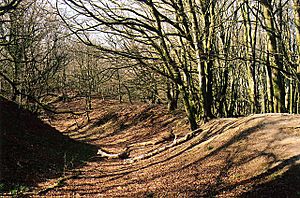Hembury facts for kids

Ramparts inside Hembury hillfort
|
|
| Location | Hembury, Devon |
|---|---|
| Coordinates | 50°49′14″N 03°15′41″W / 50.82056°N 3.26139°W |
| Type | Hillfort |
| History | |
| Periods | Neolithic, Iron Age, Roman |
| Site notes | |
| Public access | Yes |
| Website | http://www.hemburyfort.co.uk |
Hembury is a very old and important place in East Devon, England. It was once a Neolithic "causewayed enclosure" and later an Iron Age "hill fort." A causewayed enclosure was a special type of early settlement with ditches and banks. A hill fort was a strong, protected village built on a hill. Hembury is located near Honiton in Devon.
The history of Hembury goes back a very long time. People lived here from around 4,000 to 5,000 years ago, right up until the Romans arrived. The fort sits on a high point of land called a "promontory." This spot is at the end of a 240-meter-high ridge in the Blackdown Hills. It looks out over the River Otter valley. This location was probably chosen because it offered great views of the area. It also made the settlement easier to defend.
Hill forts are ancient forts found all over Britain. They were built to protect people and their homes. Some hill forts have very deep ditches in front of their walls, which are called "ramparts." Two famous hill forts in Dorset are Maiden Castle and Hambledon Hill.
Contents
A Look at Hembury's History
Hembury was first used by people in the Stone Age. Later, during the Iron Age, a hill fort was built on the same spot. This shows how important the location was for a very long time.
Early Discoveries at Hembury
Between 1930 and 1935, an archaeologist named Dorothy Liddell led excavations at Hembury. She found evidence of a wooden entrance to the causewayed enclosure. She also found an oval shape of holes in the ground. These holes were left by wooden posts. Dorothy Liddell thought these posts were from a building that burned down before the earthworks of the enclosure were built.
Other things found from the Neolithic period included pieces of pottery, flint tools, axes, and querns. Querns are special stones used for grinding grain. They also found charred grain, which is grain that was burned.
Roman Soldiers at the Fort
Later, in the 1980s, another archaeologist named Malcolm Todd led more digs. His team found signs that Roman soldiers had also used the site. This suggests that the Romans built a small fort inside the existing Iron Age hill fort. This shows that Hembury was important even during the Roman times.
What is Hembury Ware Pottery?
The site of Hembury is so famous that it gave its name to a special type of pottery. This pottery is some of the earliest Neolithic pottery found in southern Britain. Many pieces of this pottery were found during Dorothy Liddell's excavations.
Hembury ware pottery usually had round bottoms and special handles called "lugs." Lugs are small knobs or bumps that stick out. Much of this pottery was made further west, near a place called The Lizard. It was made using a type of clay called "Gabbroic clay." This pottery was traded all across the British Isles. It was made between 5,000 and 4,000 BCE. You can see several pieces of Hembury ware Gabbro pottery on display at the Royal Albert Memorial Museum in Exeter, Devon.
Images for kids
See also
 In Spanish: Hembury para niños
In Spanish: Hembury para niños



